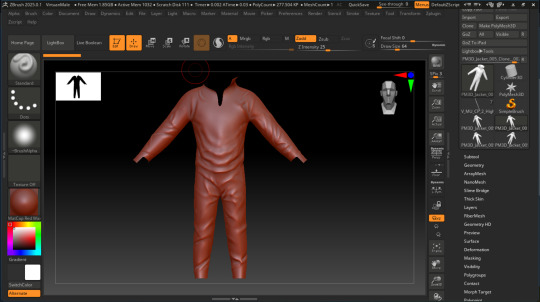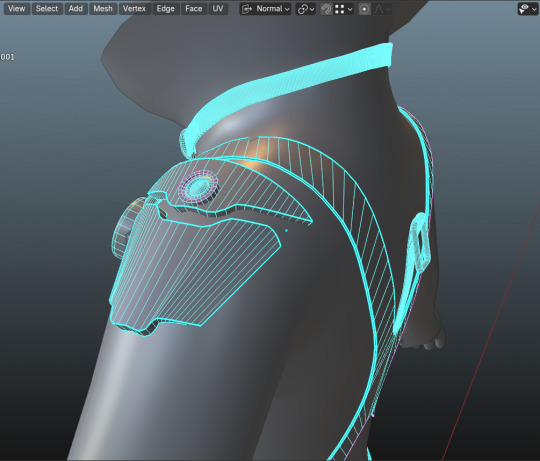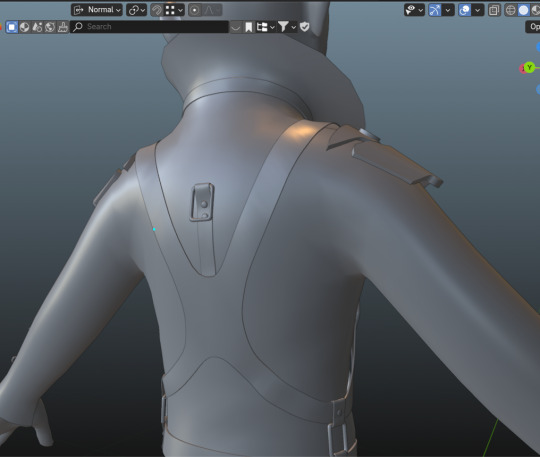#development1
Explore tagged Tumblr posts
Text
Blog Post 3: Final Steps and Reflections
Title: From Blender to Reality: Preparing for 3D Printing
In the final processes of design, I finished with modeling and texturing and then proceed to 3D printing. This involved for example making sure that the model gets the best preparations for exporting on an STL file.
Preparing for 3D Printing: The first effort was to inspect the model for embedded geometry or areas that are too thin and likely to fail during printing. I used the add-on called 3D Print Toolbox in Blender to evaluate the shape of the model and make some changes.
Once the model was validated, I exported it an STL file format this is common in 3D printing .

Challenges and Insights: One good point with this design was that it was uncomplicated, but there were problems with this as well. It did guarantee an easy print but there was always a challenge in how the playfulness of the design would meet functional needs.
Future Plans: In my next update, I intend to add more details in creases and play with the texture of the print. Thanks to this project, there are numerous opportunities for improving the everyday object through artistic intervention.

Conclusion: This assignment was a great opportunity to explore the sphere of three-dimensional printing. I also found out how it’s like to create an object, from the conceptual stage all the way to converting an STL file. Can’t wait till the chick comes out in print!
#Developing skills#Development1#3d Printing#3d model#beingmughal#art#blender 3d#artwork#blender render#being#mughal#hamxa#game#game design#hertfordshire#video games#learning games#study blog#design#digital art#3d#pureref#arcane#Jinx#arcane season 2#arcane s2#arcane fanart#arcane s2 spoilers#grenade
20 notes
·
View notes
Text
The Art Of Self-Reflection
The art of self-reflection is the practice of looking inward and examining one’s thoughts, emotions, and actions. It involves gaining a deeper understanding of oneself, one’s motivations, beliefs, strengths, and weaknesses. Self-reflection can help you improve your self-awareness, self-esteem, and self-regulation, as well as foster personal growth and development1 Some of the benefits of…

View On WordPress
2 notes
·
View notes
Text
Spiritual Process of Daily Journaling

Writing is more than just a mode of communication; it is an art form that allows us to express our most profound thoughts and emotions. When paired with the spiritual practice of daily journaling, writing becomes an extremely effective instrument for personal growth and self-discovery. This blog post delves into the junction of the art of writing and the spiritual process of journaling, with insights from notable authors such as Julia Cameron.
The Art of Writing The art of writing entails refining one’s ability to communicate ideas clearly and eloquently. According to Erin Pavlicek, mastering the skill of writing necessitates devotion and ongoing development1. Writing is more than just putting words on paper; it is about creating a story that connects with readers. This entails grasping the fundamentals of good writing, such as clarity, coherence, and inventiveness.
Finding one’s voice is an important part of the writing process. A writer’s unique voice is what distinguishes their work. Discovering and polishing this voice is a journey that takes time and practice. As Julia Cameron highlights in her book “The Right to Write,” writing should be viewed as a process rather than a finished product2. This viewpoint helps writers to concentrate on the act of writing itself rather than being overly concerned with the outcome.
The Spiritual Process of Journaling Journaling is a spiritual activity in which one records their thoughts, feelings, and experiences on a daily basis. It is a type of self-reflection in which people connect with their inner selves and receive insight into their spiritual journey. Spiritual journaling is more than just capturing daily events; it is also about discovering the deeper meaning behind those experiences and comprehending one’s spiritual growth.
According to Frederick Meyer, spiritual journaling can considerably improve personal spiritual growth by offering clarity and a feeling of purpose3. Individuals who consistently write about their spiritual experiences can measure their growth, identify patterns, and gain a better knowledge of their ideas and values.
Combining Writing and Journaling When the craft of writing is paired with the spiritual process of journaling, the outcome is a potent discipline that cultivates both creativity and spirituality. Julia Cameron’s concept of “Morning Pages” is an excellent example of this combo. Cameron’s book “The Artist’s Way” recommends writing three pages of longhand, stream-of-consciousness writing every morning4. This exercise promotes mental clarity, overcomes creative blockages, and connects with one’s inner wisdom.
Cameron also emphasizes the value of writing for direction. Individuals can get significant insights by asking questions and writing down their responses4. This technique not only boosts creativity, but it also promotes a stronger connection with one’s spiritual self.
Tips for Spiritual Journaling Consistency:
Write on a daily basis to form a habit and document continuing spiritual development5. Privacy: Keep your journal private so that you can be entirely honest about your thoughts5.
Journaling can help you reflect on readings, lessons, and experiences, cultivate a positive mindset, and solve spiritual concerns. The skill of writing and the spiritual process of journaling are inextricably linked practices that can benefit one’s life. Individuals who set aside time each day to write and ponder can boost their creativity, obtain spiritual insights, and promote personal growth. Writing, as Julia Cameron and other authors have demonstrated, is more than a skill to be learned; it is a journey to be embraced.
1 Pavlicek, E. (2015). Mastering the Art of Writing: Six Ways to Hone Your Skills & Develop Your Craft.
2 Cameron, J. (1999). The Right to Write: An Invitation and Initiation into the Writing Life.
3 Meyer, F. (2024). How to Keep a Spiritual Journal, with 46 Journaling Prompts.
4 Cameron, J. (1992). The Artist’s Way.
5 Spiritual Desk. (2024). How to Keep a Spiritual Journal: A Complete Guide.
1 note
·
View note
Text
Health Delegation in Moulay Yacoub Organizes Awareness Campaign for Pregnancy Follow-Up in Ain Kansara
Moulay Yacoub – Within the framework of activating the regional communication program for the national campaign to raise awareness about the importance of pregnancy follow-up, launched by the Ministry of Health and Social Protection in partnership with the National Initiative for Human Development1 under the slogan “Let’s Hurry and Complete Pregnancy Visits…Let’s Preserve the Health of Mother and…
0 notes
Text
QA Trends for 2025: AI, Automation, and Sustainability from a Quality Assurance Services Company
As 2025 approaches, the field of Quality Assurance (QA) is rapidly evolving, driven by technological advancements and changing industry demands. For QA Managers, decision-makers, and Project Managers, staying ahead of these trends is crucial for maintaining a competitive edge. This article, presented from the perspective of a quality assurance services company, explores the key QA trends expected to dominate in 2025.
Top QA Trends to Watch in 2025

AI and Machine Learning (ML) Integration AI and ML are poised to revolutionize software testing by automating repetitive tasks, enhancing test coverage, and accelerating defect resolution2. By 2025, AI-driven testing will be an essential component of the development lifecycle, enabling faster feedback cycles and more robust software2. AI can generate test cases, enable self-healing capabilities, create test data, prioritize tests, detect anomalies, and identify the root causes of system or test failures3. Generative AI bridges the gap between less technical business analysts, manual testers, and automated testing, simplifying test case generation and maintenance2.
Hyper automation Hyper automation involves automating as many processes as possible using advanced technologies1. This includes end-to-end automation of functional, performance, security, and compliance testing. Robotic Process Automation (RPA) will automate setup environments and generate test data, while continuous testing, deeply integrated into CI/CD pipelines, will ensure quality at all phases of development1.
Shift-Left and Shift-Right Testing Shift-left testing, which starts testing earlier in the development cycle, is now complemented by shift-right testing, which focuses on post-deployment monitoring and continuous improvement3. This ensures comprehensive quality assurance throughout the entire software development lifecycle.
Cloud-Based Quality Management Systems Cloud adoption is growing, with projections that 85% of organizations will adopt a cloud-focused approach1. Cloud-based quality management systems offer increased agility, safety, and savings1. These systems facilitate automated testing environments that identify and resolve errors faster, enabling parallel test execution and improving collaboration between teams1.
Big Data Analytics Big Data Analytics allows you to extract actionable insights from large data sets1. By 2025, organizations will use this technology to proactively identify risks, optimize workflows, and predict quality outcomes with greater accuracy1.
Sustainability in QA Sustainability is becoming a central focus, requiring companies to reduce their environmental footprint1. QA extends beyond simple material testing to improve resource efficiency and extend product lifespans. This involves increased use of recycled polymers, with QA teams testing these materials for mechanical, chemical properties, durability, and compatibility with existing production processes1.
Agile and Lean Quality Management Traditional quality management systems are evolving into more dynamic and collaborative methods through Agile and Lean Quality Management4. This approach merges the iterative nature of Agile development with the waste-elimination principles of Lean thinking, promoting flexibility and collaboration4.
The Strategic Advantage of Quality Assurance Services Companies Quality assurance services companies play a critical role in helping organizations implement and manage these emerging trends. They bring expertise in assessing project requirements, recommending suitable solutions, and providing insights into industry best practices. By partnering with a quality assurance services company, businesses can strategically optimize their QA processes and gain a competitive edge.
Conclusion: Preparing for the Future of QA The QA landscape in 2025 will be shaped by AI, automation, cloud technologies, and a focus on sustainability. Organizations that proactively embrace these trends will be best positioned to deliver high-quality products efficiently and effectively. Engaging with a reputable quality assurance services company can provide the expertise and support needed to navigate these changes and implement successful QA strategies.
#qualityassuranceservices#qualityassurancetesting#qualityassurancecompany#quality assurance services
0 notes
Text
UX/UI
Exploring the Intersection of UX/UI Design and Mobile App DevelopmentIn today's digital landscape, mobile app development is at the forefront of innovation, with user experience (UX) and user interface (UI) design playing a critical role in shaping successful applications. This article explores how UX/UI design and mobile app development intersect to create seamless, functional, and visually appealing apps that meet user needs and business goals.---The Importance of UX/UI Design in Mobile App DevelopmentUX/UI design serves as the foundation of mobile app development, ensuring that users interact with apps effortlessly while enjoying a visually engaging interface.User Experience (UX): Focuses on the overall feel of the app, emphasizing usability, accessibility, and efficiency. It ensures users can achieve their goals without frustration.User Interface (UI): Deals with the aesthetic aspects, including typography, color schemes, and layout, creating an intuitive and visually appealing interface.When combined, UX and UI design drive user satisfaction, loyalty, and engagement, making them indispensable to the development process.---Key Elements at the Intersection1. User-Centered Design:Both UX/UI design and app development prioritize understanding user needs and preferences through research, personas, and journey mapping.2. Prototyping and Testing:UX/UI designers create wireframes and prototypes to visualize app functionality, while developers refine and test these designs to ensure technical feasibility.3. Iterative Development:Continuous feedback loops between designers and developers enable ongoing improvements, aligning design concepts with real-world user behavior.4. Performance Optimization:Developers ensure the app performs efficiently, while UX/UI designers minimize cognitive load through intuitive navigation and layout design.5. Cross-Platform Consistency:UX/UI designers maintain consistency across iOS and Android platforms, while developers ensure compatibility without compromising functionality or aesthetics.---Emerging Trends in UX/UI and Mobile App Development1. Dark Mode Design:Enhances visual appeal and reduces eye strain, requiring developers to adjust codebases to accommodate different themes seamlessly.2. Voice and Gesture-Based Interfaces:UX/UI designers integrate voice commands and gestures, while developers work on advanced algorithms for accurate recognition.3. Personalization:Data-driven designs allow apps to adapt to individual preferences, with developers building robust back-end systems to support personalization.4. Micro-Interactions:Subtle animations and feedback loops designed by UX/UI experts are implemented by developers to boost user engagement.5. Accessibility:Designing for inclusivity involves creating apps accessible to people with disabilities, combining thoughtful design with technical adaptability.---Collaboration Between UX/UI Designers and DevelopersEffective collaboration between UX/UI designers and developers is essential to create apps that are both functional and delightful.Clear Communication: Regular meetings and design reviews foster understanding of design and technical constraints.Shared Tools: Platforms like Figma, Adobe XD, and Sketch bridge the gap, enabling designers to hand off assets directly to developers.Agile Methodology: Iterative workflows keep both teams aligned on project goals and timelines.---ConclusionThe intersection of UX/UI design and mobile app development is where innovation meets functionality. By prioritizing user needs, maintaining effective collaboration, and staying ahead of trends, designers and developers create mobile applications that not only meet but exceed user expectations. In an ever-evolving digital landscape, this synergy is the key to delivering apps that resonate with users and drive business success.Would you like assistance with visuals or infographics to accompany this article?
#UI/UX Design Services for Startups in Dubai#Affordable Web Design for Small Businesses in Dubai#Custom App Design Solutions in Dubai#Professional Branding Services for New Companies in Dubai#Responsive Website Design Experts in Dubai#User-Centric Mobile App Design in Dubai#E-commerce Website UI/UX Design in Dubai#Innovative Digital Product Design Agency in Dubai#High-Converting Landing Page Design Services in Dubai#Comprehensive UX Strategy Consulting in Dubai#UI ( User interface )#UX (User experience)#Wireframe#Design#User Research#Usability Testing#Web design#Website development#Responsive web design#UX/UI design#Graphic design for websites#Web design company#Flat web design#Brand identity design#Logo design#Social media branding#Brand logo design#Mobile app design#iOS app design#Android app design
1 note
·
View note
Text
UX/UI
Exploring the Intersection of UX/UI Design and Mobile App DevelopmentIn today's digital landscape, mobile app development is at the forefront of innovation, with user experience (UX) and user interface (UI) design playing a critical role in shaping successful applications. This article explores how UX/UI design and mobile app development intersect to create seamless, functional, and visually appealing apps that meet user needs and business goals.---The Importance of UX/UI Design in Mobile App DevelopmentUX/UI design serves as the foundation of mobile app development, ensuring that users interact with apps effortlessly while enjoying a visually engaging interface.User Experience (UX): Focuses on the overall feel of the app, emphasizing usability, accessibility, and efficiency. It ensures users can achieve their goals without frustration.User Interface (UI): Deals with the aesthetic aspects, including typography, color schemes, and layout, creating an intuitive and visually appealing interface.When combined, UX and UI design drive user satisfaction, loyalty, and engagement, making them indispensable to the development process.---Key Elements at the Intersection1. User-Centered Design:Both UX/UI design and app development prioritize understanding user needs and preferences through research, personas, and journey mapping.2. Prototyping and Testing:UX/UI designers create wireframes and prototypes to visualize app functionality, while developers refine and test these designs to ensure technical feasibility.3. Iterative Development:Continuous feedback loops between designers and developers enable ongoing improvements, aligning design concepts with real-world user behavior.4. Performance Optimization:Developers ensure the app performs efficiently, while UX/UI designers minimize cognitive load through intuitive navigation and layout design.5. Cross-Platform Consistency:UX/UI designers maintain consistency across iOS and Android platforms, while developers ensure compatibility without compromising functionality or aesthetics.---Emerging Trends in UX/UI and Mobile App Development1. Dark Mode Design:Enhances visual appeal and reduces eye strain, requiring developers to adjust codebases to accommodate different themes seamlessly.2. Voice and Gesture-Based Interfaces:UX/UI designers integrate voice commands and gestures, while developers work on advanced algorithms for accurate recognition.3. Personalization:Data-driven designs allow apps to adapt to individual preferences, with developers building robust back-end systems to support personalization.4. Micro-Interactions:Subtle animations and feedback loops designed by UX/UI experts are implemented by developers to boost user engagement.5. Accessibility:Designing for inclusivity involves creating apps accessible to people with disabilities, combining thoughtful design with technical adaptability.---Collaboration Between UX/UI Designers and DevelopersEffective collaboration between UX/UI designers and developers is essential to create apps that are both functional and delightful.Clear Communication: Regular meetings and design reviews foster understanding of design and technical constraints.Shared Tools: Platforms like Figma, Adobe XD, and Sketch bridge the gap, enabling designers to hand off assets directly to developers.Agile Methodology: Iterative workflows keep both teams aligned on project goals and timelines.---ConclusionThe intersection of UX/UI design and mobile app development is where innovation meets functionality. By prioritizing user needs, maintaining effective collaboration, and staying ahead of trends, designers and developers create mobile applications that not only meet but exceed user expectations. In an ever-evolving digital landscape, this synergy is the key to delivering apps that resonate with users and drive business success.Would you like assistance with visuals or infographics to accompany this article?
#UI/UX Design Services for Startups in Dubai#Affordable Web Design for Small Businesses in Dubai#Custom App Design Solutions in Dubai#Professional Branding Services for New Companies in Dubai#Responsive Website Design Experts in Dubai#User-Centric Mobile App Design in Dubai#E-commerce Website UI/UX Design in Dubai#Innovative Digital Product Design Agency in Dubai#High-Converting Landing Page Design Services in Dubai#Comprehensive UX Strategy Consulting in Dubai#UI ( User interface )#UX (User experience)#Wireframe#Design#User Research#Usability Testing#Web design#Website development#Responsive web design#UX/UI design#Graphic design for websites#Web design company#Flat web design#Brand identity design#Logo design#Social media branding#Brand logo design#Mobile app design#iOS app design#Android app design
0 notes
Text
Rio Tinto and Sumitomo Metal Mining to partner on Winu copper-gold project
Rio Tinto and Sumitomo Metal Mining (SMM) have signed a Term Sheet for a Joint Venture to deliver the Winu copper-gold project, located in the Great Sandy Desert region of Western Australia.

Under the Term Sheet, which includes exclusivity obligations to work towards a binding Definitive Agreement, Rio Tinto will continue to develop and operate Winu as managing partner and SMM will pay Rio Tinto $399 million for a 30% equity share of the project. This includes $195 million upfront and $204 million in deferred considerations contingent on milestones and adjustments to be agreed. The parties have also entered into a letter of intent to develop a broader strategic partnership to work together to explore opportunities for commercial, technical and strategic collaboration across copper, other base metals and lithium. The Winu project is an attractive low-risk, long-life copper-gold deposit discovered by Rio Tinto in 2017, that is highly prospective for expansion beyond the initial development1. It is located in proximity to Rio Tinto’s Pilbara iron ore assets. Rio Tinto and SMM will now work to finalise definitive agreements for the Winu project joint venture in the first half of 2025, along with formalising the broader strategic partnership. Rio Tinto will also continue to focus on its partnership with the Nyangumarta Traditional Owners, including progressing Project Agreement negotiations2. A pre-feasibility study for the Winu project with an initial development of processing capacity of up to 10 mtpa is expected to be completed in 2025, along with the submission of an Environmental Review Document under the EPA Environmental Impact Assessment process. Rio Tinto Copper Chief Executive Katie Jackson said: “We share a long history with Sumitomo Metal Mining as partners and deeply value the commitment they will bring to the Winu project. This is a unique opportunity to derisk our investment, as we work with an experienced partner. We look forward to working more broadly as strategic partners to find new ways to deliver value across the metals and minerals supply chain. “Progress in 2024 including the attractive partnership proposal from Sumitomo Metal Mining has cemented the path forward for Winu to deliver profitable growth. We will continue to advance the Winu project in close partnership with the Nyangumarta Traditional Owners and the Karlkayn airstrip with the Martu Traditional Owners, in a way that benefits all parties.” Sumitomo Metal Mining General Manager of Mineral Resources Division Hideyuki Okamoto said: “We look forward to renewing our long-standing relationship with Rio Tinto by partnering on the highly attractive Winu Project. We are also excited to explore further opportunities for collaboration given the strong alignment between our companies.” The closing of the transaction will be subject to obtaining any necessary consents and approvals, and the satisfaction of customary conditions. Original Source: https://bit.ly/4fs7Dc8
0 notes
Text
Grin Cryptocurrency: A Privacy-Preserving Digital Currency
Grin Cryptocurrency: A Privacy-Preserving Digital Currency
Grin is a decentralized and privacy-focused cryptocurrency that utilizes the Mimblewimble protocol to offer a unique balance of privacy and scalability. Launched in January 2019, Grin aims to provide secure and anonymous transactions without compromising on efficiency.To get more news about grin crypto, you can visit our official website.
Understanding Grin and Mimblewimble
Grin operates on the Mimblewimble protocol, which allows for confidential transactions by hiding the amounts and addresses involved. This protocol also eliminates the need to store data on spent outputs, making the blockchain lightweight and minimalistic. The result is a digital currency that prioritizes user privacy while maintaining a scalable network.
Key Features of Grin
Privacy: Grin ensures that transaction details such as amounts and addresses are kept confidential.
Scalability: The Mimblewimble protocol allows for efficient transaction processing without bloating the blockchain.
Open-Source: Grin is fully open-source and community-driven, with no single entity controlling its development.
Fair Distribution: Grin's coin distribution is designed to be fair, with a constant emission rate of 1 GRIN per second.
How Grin Works
Grin transactions are designed to be aggregated and relayed among a subset of peers before being broadcasted widely. This process helps to obscure the origin of new transactions, enhancing privacy. The blockchain is maintained by a network of volunteers who contribute to its development and security.
Getting Started with Grin
To start using Grin, you can download the necessary software from the official Grin website and join the community of developers and users. The project relies on donations for funding and encourages community participation in its ongoing development1.
Conclusion
Grin represents a significant advancement in the realm of privacy-preserving cryptocurrencies. By leveraging the Mimblewimble protocol, Grin offers a secure and scalable solution for users seeking anonymity in their transactions. As the project continues to evolve, it remains a promising option for those interested in decentralized and private digital currencies.
0 notes
Text
The Unique Influence of Mothers on Child Development Within Co-Parenting
Introduction: Mothers’ Influence in Co-Parenting and Child Development1. Why Mothers Often Have a Stronger Impact on Child Development2. Emotional and Behavioral Benefits for Children Under Maternal Influence3. The Bible’s Perspective on Maternal Influence4. Practical Steps for Mothers to Enhance Co-Parenting5. Strengthening the Co-parenting Relationship with Mutual SupportConclusion: Embrace the…
0 notes
Text
How to Build a Strong Study Plan for IAS Preparation

Preparing for the Indian Administrative Service (IAS) examination is a monumental task that requires dedication, strategic planning, and effective time management. With the competition being fierce and the syllabus vast, having a well-structured study plan is crucial for success. In this blog post, we will guide you on how to build a strong study plan for IAS preparation, ensuring you utilize your time efficiently and cover all essential topics.
Understanding the IAS Examination
Before diving into the specifics of creating a study plan, it’s essential to have a clear understanding of the IAS examination structure. The IAS exam consists of three stages:
Preliminary Examination: This is a screening test that consists of two objective-type papers. General Studies Paper-I and General Studies Paper-II (CSAT).
Mains Examination: This stage includes nine papers, of which two are language papers, one is an essay paper, and the remaining papers are focused on general studies and optional subjects.
Interview: Also known as the Personality Test, this is the final stage where candidates are assessed on their personality, communication skills, and knowledge.
Given the extensive syllabus, effective preparation is imperative.
Step-by-Step Guide to Building a Study Plan
1. Assess Your Current Knowledge and Skills
Before you start creating your study plan, evaluate your current understanding of the subjects. Identify your strengths and weaknesses, and note the areas that require more attention. This self-assessment will help you allocate more time to challenging topics while maintaining your strengths.
2. Set Clear Goals
Establish specific, measurable, achievable, relevant, and time-bound (SMART) goals. For instance, aim to cover a particular topic or subject within a certain timeframe. Setting clear goals will help you stay focused and motivated throughout your preparation.
3. Research the Syllabus and Exam Pattern
Familiarize yourself with the IAS exam syllabus and the examination pattern. You can find detailed syllabi on the official UPSC website. Make sure to understand the weightage of different subjects and topics, which will help you prioritize your study plan effectively.
4. Create a Timetable
A well-structured timetable is essential for effective IAS preparation. Here’s how to create one:
Daily Study Hours: Dedicate a specific number of hours each day for your IAS preparation. Ensure that you maintain a balance between study and leisure to avoid burnout.
Subject-wise Allocation: Divide your time based on the subjects and topics. Allocate more time to subjects that are challenging for you.
Weekly and Monthly Goals: Set weekly and monthly targets to cover specific topics. Regularly review your progress and make adjustments to your plan as necessary.
Sample Weekly Timetable
DayTimeSubject/ActivityMonday6:00 AM - 8:00 AMCurrent Affairs (Newspaper)9:00 AM - 12:00 PMHistory (Ancient India)1:00 PM - 3:00 PMGeography (Physical Geography)4:00 PM - 6:00 PMPractice Mock TestsTuesday6:00 AM - 8:00 AMPolity (Indian Constitution)9:00 AM - 12:00 PMEnvironment and Ecology1:00 PM - 3:00 PMEssay Writing Practice4:00 PM - 6:00 PMRevisionWednesday6:00 AM - 8:00 AMEconomics9:00 AM - 12:00 PMGeography (Human Geography)1:00 PM - 3:00 PMCSAT Practice4:00 PM - 6:00 PMOptional Subject PreparationThursday6:00 AM - 8:00 AMScience and Technology9:00 AM - 12:00 PMHistory (Medieval India)1:00 PM - 3:00 PMEthics and Integrity4:00 PM - 6:00 PMRevisionFriday6:00 AM - 8:00 AMCurrent Affairs (News Analysis)9:00 AM - 12:00 PMPractice Mock Tests1:00 PM - 3:00 PMSocial Issues4:00 PM - 6:00 PMOptional Subject PreparationSaturday6:00 AM - 8:00 AMGroup Study9:00 AM - 12:00 PMRevision1:00 PM - 3:00 PMPrevious Year Question Papers4:00 PM - 6:00 PMBreak/Leisure ActivitiesSunday6:00 AM - 8:00 AMRest and Reflection9:00 AM - 12:00 PMPersonal Development1:00 PM - 3:00 PMPlanning for the Week Ahead4:00 PM - 6:00 PMLight Revision
5. Utilize Quality Study Materials
Choosing the right study materials is crucial for effective preparation. Invest in standard textbooks, online courses, and coaching resources. Enroll in the best IAS academy in Coimbatore for expert guidance and structured learning. Many top academies offer comprehensive study materials, mock tests, and mentoring to help you excel.
6. Focus on Current Affairs
Current affairs play a significant role in both the Preliminary and Mains examinations. Stay updated with the latest news and events by reading newspapers, magazines, and online news portals. Allocate time daily to cover current affairs, which will also help in essay writing and interviews.
7. Practice Mock Tests and Previous Year Papers
Regularly practicing mock tests is essential for evaluating your preparation and improving your speed and accuracy. Attempting previous year papers will give you insights into the exam pattern and the types of questions asked. Make it a point to analyze your performance after each test and work on your weak areas.
8. Revision is Key
Revising regularly is critical to retaining information. Create a revision schedule to review topics you’ve studied weekly. Focus on summarizing notes and creating mind maps to visualize complex concepts. Remember, consistent revision helps reinforce your learning.
9. Join a Study Group
Collaborating with fellow aspirants can provide you with new perspectives and motivate you to stay on track. Joining a study group or a forum allows you to share resources, discuss doubts, and learn collectively. Engaging in discussions can also enhance your understanding of various subjects.
10. Maintain Your Health
Your physical and mental well-being is paramount during your preparation. Ensure that you get enough sleep, eat a balanced diet, and engage in regular physical activity. Mindfulness practices, such as meditation or yoga, can help reduce stress and improve concentration.
11. Seek Guidance from Mentors
Having a mentor or guidance from experienced IAS officers can provide valuable insights into effective preparation strategies. If you’re enrolled in the best IAS academy in Coimbatore, take advantage of the faculty’s experience and seek advice on your study plan.
12. Stay Positive and Motivated
Finally, maintain a positive attitude throughout your preparation journey. It’s natural to feel overwhelmed at times, but keeping a motivated mindset will help you overcome challenges. Celebrate your small achievements and stay focused on your long-term goals.
Conclusion
Building a strong study plan for IAS preparation is essential for success in this highly competitive examination. By assessing your current knowledge, setting clear goals, creating a structured timetable, and utilizing quality study materials, you can pave the way for effective preparation. Don’t forget to prioritize your health, seek guidance, and maintain a positive outlook.
Embarking on the IAS preparation journey can be daunting, but with the right strategy and mindset, you can turn your aspirations into reality. Consider enrolling in the best IAS academy in Coimbatore to enhance your preparation and gain access to expert resources.
Hashtags
#BestIASAcademyInCoimbatore #IASPreparation #StudyPlanForIAS
0 notes
Text
Blog Post 2: Sculpting and Modeling
Title: Overcoming Challenges in a “bit” of 3D : Sculpting in ZBrush and Modeling in Blender
The next stage was to model the character in ZBrush and other more details and changes in the program called as Blender. With this being a post from a beginner to ZBrush, this phase was challenging and at the same rewarding at times.
youtube
Sculpting in ZBrush: So, using Sketchfab, I copied a base male model to ZBrush to start modeling the mechanical suit. The learning curve was steep here, but I used intermediate level tutorials in YouTube to help me. These tutorials were particularly useful while learning about brushes, sculpting and some of the features of ZBrush.

Using Blender for Additional Modeling: For the mechanical tools and accessories I decided to go with Blender. It was also easy to navigate; I was able to create complex geometry and even hone on details. Blender was also used for the UV unwrap of the suit and low poly modeling.


Challenges and Solutions: 1. Working on accurate mechanical outlines in ZBrush was rather challenging. Also I used some navigation videos like Intermediate ZBrush Sculpting Tutorial to enhance my efficiency.
youtube
2. Blender’s UV tools also assisted the proper unwrapping for texturing in the subsequent phase, although texturing was not done at this level.
youtube
The modelling phase comprises problem-solving and improved knowledge of sculpting and modelling production processes that were exercised during this phase. Both tools had their strengths which provided a good basis of the final presentation of the project.
References:
Blender Foundation (2024). Blender Manual. Available at: https://docs.blender.org/manual/en/latest/c[26 November 2024].
Pixologic (2024). ZBrush Central. Available at: https://www.zbrushcentral.com/ [26 November 2024].
Ryan King Art(2024). New UV Unwrapping Options in Blender 4.3. Available at: https://www.youtube.com/watch?v=hQ8HvDuSWCQ [26 November 2024].
Danny Mac 3D(2018). How to SCULPT CLOTH the EASY WAY! - Zbrush Tutorial. https://youtu.be/3SkDJhO3j2U?feature=shared [26 November 2024].
#Developing skills#Development1#a bit of 3d#beingmughal#3d model#art#blender 3d#artwork#blender render#being#mughal#hamxa#game#game design#hertfordshire#video games#learning games#study blog#design#digital art#envoirnment light#Youtube#3d#zbrush#sculpt#scifi#suite
3 notes
·
View notes
Text
Work From Home with Top Freelance Websites to Start New Life
Here are some of the top freelance job websites where you can find a variety of opportunities
Here are some of the top freelance job websites where you can find a variety of opportunities: Upwork: A popular platform for freelancers in many fields, including writing, design, and development1. Fiverr: Known for its gig-based system, it’s great for freelancers offering services like graphic design, writing, and digital marketing2. Toptal: Focuses on connecting businesses with top…
0 notes
Text
Pharmacy Website Design and App Development: Understanding Significance Features and Types
In the fast-paced and ever-evolving healthcare landscape, technology has become an indispensable tool in enhancing patient access and experiences. Among the transformative innovations, pharmacy app development emerge as powerful solutions bridging the gap between patients and healthcare services. With their user-friendly interfaces, secure prescription management, and personalized features, these digital platforms are revolutionizing the way pharmacies interact with patients, creating a seamless and efficient healthcare journey. This article delves into the profound significance of pharmacy website design and app development, exploring their transformative impact on healthcare access and elevating the patient experience.

The Significance of Pharmacy Website Design and App Development
1. Expanded Healthcare Access: Pharmacy websites and apps break geographical barriers, providing patients with round-the-clock accessibility to essential healthcare services. With the convenience of ordering medications and healthcare products from the comfort of their homes, these platforms prove especially valuable to those in remote or underserved areas.
2. Enhanced User Experience: At the heart of well-designed pharmacy websites and apps lies a focus on user experience. Patients encounter intuitive navigation, clear information, and easy-to-use features that streamline the process of finding medications, accessing prescription details, and managing their healthcare needs. As a result, patient satisfaction soars, fostering long-lasting relationships between patients and pharmacies.
3. Medication Information and Education: Pharmacy platforms serve as valuable sources of comprehensive medication information, offering usage instructions, potential side effects, and drug interactions. Empowered with knowledge, patients can make informed decisions, thereby promoting medication adherence and contributing to improved health outcomes.
4. Online Consultation and Telemedicine: The seamless integration of telemedicine features in pharmacy apps empowers patients to consult with pharmacists or healthcare professionals online. This convenience proves particularly beneficial for addressing non-emergency medical queries and seeking expert advice from the comfort of one's home, enhancing the accessibility of healthcare services.
5. Personalized Health Management: Tailored to each patient's unique needs, pharmacy apps offer personalized features like medication reminders, dosage tracking, and customized health recommendations based on individual profiles. This personalized approach enables patients to manage their healthcare more effectively and proactively.
6. Prescription Management and Refills: Pharmacy apps simplify prescription management by allowing patients to upload prescriptions and easily request medication refills. This efficient process reduces wait times and ensures seamless medication continuity, leading to improved patient convenience and satisfaction.
7. Secure and Convenient Payments: The integration of secure payment gateways instills confidence in patients, ensuring that they can conveniently and confidently pay for medications and healthcare products while knowing that their payment information remains safeguarded.
8. Health Record Management: Robust pharmacy apps securely store patient health records and prescription history, granting patients easy access to their medical history and enabling healthcare professionals to make well-informed decisions based on accurate data.
9. Customer Loyalty and Trust: A positive user experience on a user-friendly and reliable pharmacy website or app fosters customer loyalty and trust. Patients are more likely to return to a platform that consistently delivers a seamless and trustworthy healthcare experience.
10. Market Reach and Business Growth: By establishing a robust online presence through websites and apps, pharmacies can expand their market reach beyond physical locations. This strategic move opens doors to a broader customer base, leading to business growth and increased revenue opportunities.
11. Data-Driven Insights: Pharmacy platforms generate valuable data on patient preferences, medication trends, and health patterns. Analyzing this data empowers pharmacies to make data-driven decisions, optimize their services, and ultimately enhance patient outcomes.
Key Features Paving the Way for Transformation
1. User-Friendly Interface: Intuitive and easy-to-navigate interfaces ensure patients can quickly find medications, healthcare products, and relevant information with minimal effort, delivering a delightful user experience.
2. Medication Search and Ordering: Robust search functionality simplifies the process of finding specific medications, brands, or health products, while streamlined medication ordering through a user-friendly shopping cart and checkout process enhances overall user convenience.
3. Prescription Upload and Verification: Enabling patients to directly upload prescriptions on the website or app, along with a secure verification process, ensures legitimacy and validity before fulfilling orders, maintaining the highest standards of safety and accuracy.
4. Medication Information: Comprehensive and detailed information about medications, including dosage, usage instructions, side effects, and precautions, empowers patients to make informed healthcare decisions, thereby promoting patient engagement and responsibility.
5. Secure Payment Gateway: The seamless integration of a secure and reliable payment gateway ensures that patient payment information remains encrypted and protected against unauthorized access, fostering trust and confidence in the platform.
6. Medication Reminders: Features like medication reminders through push notifications or emails support patients in adhering to prescribed dosages and schedules, significantly enhancing medication adherence and patient outcomes.
7. Telemedicine Integration: The incorporation of telemedicine features provides patients with online consultations, enabling virtual access to healthcare professionals, and expanding healthcare access beyond physical boundaries.
8. Personalized User Accounts: User account registration offers patients the ability to manage their health records, prescriptions, and preferences, delivering a tailored and personalized healthcare experience that caters to individual needs.
9. Prescription Refill Management: Streamlined prescription refill management allows patients to easily request refills through their user accounts, with timely updates on prescription statuses and estimated delivery times, reducing patient wait times and ensuring medication continuity.
10. Customer Support: Accessible customer support channels, including live chat, email, or helpline, ensure prompt and effective resolution of patient inquiries and concerns, fostering a strong sense of patient care and support.
11. Health Resources and Information: A comprehensive database of health resources and information educates patients on various health conditions, treatments, and preventive measures, empowering them to make informed healthcare decisions.
12. Cross-Platform Compatibility: Websites and apps designed for compatibility across multiple platforms, including iOS and Android, broaden the reach and accessibility of the pharmacy platform, catering to a diverse audience.
13. Secure Data Management: Robust security measures safeguard patient data, ensuring compliance with healthcare regulations, and restricting access to authorized personnel only, maintaining patient confidentiality and trust.
14. Analytics and Insights: Data analytics capabilities enable tracking of user behavior, medication trends, and patient interactions, guiding informed decisions and service optimization, leading to continuous improvement and enhanced patient experiences.
15. Fast Loading Times: Optimized performance ensures fast loading times, a critical factor in enhancing user experience and minimizing user frustration, elevating the overall efficiency and usability of the platform.
Types of Pharma Applications
As the pharmaceutical industry continues to embrace digital transformation, innovative types of pharma applications are emerging, revolutionizing how we access healthcare. Let's explore some of these transformative applications:
E-Commerce Pharmacy Apps: Streamlining the process of buying medications and medical supplies online, these apps offer features like prescription uploads, drug information, and secure payment options. Online pharmacy app development focuses on creating user-friendly, secure platforms, empowering patients with seamless access to medications and healthcare products.
Prescription Management Apps: Simplifying medication adherence and tracking for patients and caregivers, these apps provide reminders, dosage information, and drug interaction alerts. Pharmacy app development companies prioritize user experience and functionality in these apps, enhancing medication management and patient care.
Drug Information Apps: These apps offer in-depth information about medications, including indications, side effects, and dosage, catering to healthcare professionals and patients seeking knowledge about specific drugs. Pharmaceutical website design incorporates user-friendly navigation and comprehensive data, enabling users to access accurate and reliable drug information.
Pharmacy Loyalty Programs: Designed to encourage customer retention and repeat business, these apps offer exclusive offers and rewards to loyal customers. Integrating with e-commerce platforms or operating as standalone apps, pharmacy web design considers seamless integration with loyalty program apps to foster patient loyalty and engagement.
Telemedicine Apps: Facilitating virtual consultations with healthcare professionals, telemedicine apps enable patients to connect with doctors for advice, diagnosis, and prescriptions. Pharmacy website design integrates telemedicine capabilities for improved patient care and accessibility to healthcare services.
Drug Inventory Management Apps: These apps help pharmacies monitor and manage their stock levels and expiry dates, streamlining the process of ordering and receiving supplies. Pharmacy app development focuses on improving operational efficiency for pharmacies, contributing to effective inventory management and enhanced patient care.
Pharmacy Management Systems: Automating various pharmacy processes, such as billing, inventory management, and patient records, these systems increase efficiency and reduce the risk of errors in daily operations. Incorporating robust management features, pharmaceutical website design ensures seamless integration and streamlined pharmacy operations.
How can we Help?
At CronJ our healthcare app development services include the creation of patient portals, patient data analytics, and medical records management, as well as EHR connectors and HL7 data, all while ensuring that all healthcare applications are HIPAA compliant. We, as a healthcare app development business, have reached a significant milestone while working with some of the world’s biggest healthcare institutions.
Healthcare app development has aided some of the world’s biggest healthcare companies in finding a more efficient way to deliver enhanced treatment and even achieve better results. As a result, healthcare app development is something you should consider. Aside from AI, we include data analytics into our healthcare apps to empower healthcare professionals with large data analysis skills. As a result, delivering a diagnosis becomes easier, allowing for improved care and outcomes.
Conclusion: Empowering Healthcare Access with Digital Solutions
Pharmacy website design and app development stand at the forefront of advancing healthcare access and improving patient experiences. With expanded accessibility, enhanced user experiences, personalized features, and secure prescription management, these digital platforms empower patients to manage their healthcare conveniently and confidently. Moreover, the data-driven insights they provide enable pharmacies to continuously improve and adapt to the evolving needs of patients. Embracing healthcare industry or pharmacy website design and app development sets the stage for a seamless and empowered patient experience, ultimately contributing to improved health outcomes and patient satisfaction. As we innovate and evolve with the latest technologies, the transformative power of these digital solutions will continue to shape the future of healthcare, revolutionizing the way we access and experience medical services.
#Pharmacy website design and app development#Pharmacy website design#Pharmacy app development#app development#Healthcare app development#healthcare app development services
0 notes
Text
Practice 1: Development Project 1 - BOOM Grenade - Project Reflection

With the conclusion of this first development project I believe I have achieved all of the goals I set out to achieve. With my first dive into stylized art I have created an asset from start to finish. Exploring a variety of new techniques and styles and learning so much on the way. The final product came out fantastic, and was received well on a variety of platforms and with peers. This has helped guide my direction for the next semester as I continue to explore this new art style.
With any project, there are a few things I would have liked to improve. Including:
UV seams
Polycount
Refine Modelling to get even closer to reference
Expand on sculpt to add surface details/refine edge details
Expand on stylized texturing, paying closer attention to hand-painted textures used within Arcane
All of these points can be improved upon, and are certainly part of the learning process. There are a few other things I would have loved to do, including:
Rigging and Animating
Renders inside Game engine
Explosion FX
However these are just little extras that would be nice to have.
In conclusion, this project has been a great success, surpassing my personal expectations and guiding my learning toward my future career. I look forward to what I can create with my second development project, as well as in the future here at UH.
- Citations -
Arcane, 2021. Netflix, Riot Games.
0 notes





